- IB Style Question Banks with Solution
- IB DP Biology SL- IB Style Practice Questions with Answer-Topic Wise-Paper 1
- IB DP Biology HL- IB Style Practice Questions with Answer-Topic Wise-Paper 1
- IB DP Biology SL- IB Style Practice Questions with Answer-Topic Wise-Paper 2
- IB DP Biology HL- IB Style Practice Questions with Answer-Topic Wise-Paper 2
3.5 Genetic Modification and Biotechnology
Essential Idea:
Scientists have developed techniques for artificial manipulation of DNA, cells and organisms
Understandings:
- PCR can be used to amplify small amounts of DNA
- Gel electrophoresis is used to separate proteins or fragments of DNA according to size
- DNA profiling involves comparison of DNA
- Genetic modification is carried out by gene transfer between species
- Clones are groups of genetically identical organisms, derived from a single original parent cell
- Many plant species and some animal species have natural methods of cloning
- Animals can be cloned at the embryo stage by breaking up the embryo into more than one group of cells
- Methods have been developed for cloning adult animals using differentiated cells
Applications:
- Use of DNA profiling in paternity and forensic investigations
- Gene transfer to bacteria using plasmids makes use of restriction endonucleases and DNA ligase
- Assessment of the potential risks and benefits associated with genetic modification of crops
- Production of cloned embryos produced by somatic cell nuclear transfer
Skills:
- Design of an experiment to assess one factor affecting the rooting of stem cuttings
- Analysis of examples of DNA profiles
- Analysis of data on risks to monarch butterflies of Bt crops
- Match restriction enzyme names to the bacteria in which they are naturally found.
- Describe the role of restriction enzymes in nature and in biotechnology applications.
- Contrast sticky vs. blunt ends.
- Identify a restriction site as either leaving sticky or blunt ends.
- Demonstrate accurate use of a micro-pipette.
- Determine the number and size of DNA fragments after being exposed to restriction enzymes (both linear and plasmid DNA).
- Explain the function and purpose of DNA electrophoresis.
- Describe how and why DNA fragments separate during electrophoresis.
- Outline the functions of the buffer, marker and loading dye in DNA electrophoresis.
- State the function of the PCR.
- Describe the selectivity of the PCR.
- Outline the process of DNA profiling.
- Outline how the universality of the genetic code allows for gene transfer between species.
- Contrast sexual and asexual reproduction.
- Define clone and cloning.
- Describe different ways in which natural clones can arise.
- Define clone.
- Outline two examples of natural cloning in plants.
- Describe the process of reproductive cloning via embryo splitting.
- Outline example of cloning animal embryos via natural and artificial embryo splitting.
- Describe the process of reproductive cloning via somatic cell nuclear transfer.
- Outline the production of Dolly the sheep using somatic cell nuclear transfer.
- List example sources of DNA that can be used in DNA profiling.
- Describe a technique for genetic modification including plasmids, restriction enzymes, reverse transcriptase and ligase.
- Outline why plasmids with genes coding for antibiotic resistance are chosen as vectors in gene transfer between species.
- Outline potential environmental, health and agricultural benefits and risks associated with genetic modification of crops.
- Assess the risks and benefits of an example of a genetically modified crop (i.e. golden rice).
- Compare therapeutic cloning to reproductive cloning.
- Outline the production of embryos via somatic cell nuclear transfer.
- Outline preparation of a plant for rooting of a stem cutting.
- List manipulated, responding and controlled variables in an experiment of rooting stem-cuttings.
- Analyze a DNA profile to determine relatedness or forensic guilt.
- Outline the formation and use of Bt crops in agriculture.
- Assess the impact of Bt corn on monarch butterflies.
- State two ways in which the risk of scientific research can be assessed.
Topic 3.5 Genetic modification and biotechnology
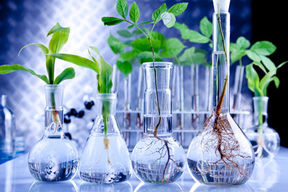
In the DNA Biotechnology unit students are apply their learning of DNA structure to biotechnological applications. DNA electrophoresis, sequencing and databases are studied.
The unit is planned to take 3 school days
Essential idea:
- Biologists have developed techniques for artificial manipulation of DNA, cells and organisms.
Nature of science:
- Assessing risks associated with scientific research—scientists attempt to assess the risks associated with genetically modified crops or livestock. (4.8)
3.5.U1 Gel electrophoresis is used to separate proteins or fragments of DNA according to size. (Oxford Biology Course Companion page 187).
- Match restriction enzyme names to the bacteria in which they are naturally found.
- Describe the role of restriction enzymes in nature and in biotechnology applications.
- Contrast sticky vs. blunt ends.
- Determine the number and size of DNA fragments after being exposed to restriction enzymes (both linear and plasmid DNA).
- Demonstrate accurate use of a micro-pipette.
- Explain the function and purpose of DNA electrophoresis.
- Describe how and why DNA fragments separate during electrophoresis.
- Outline the functions of the buffer, marker and loading dye in DNA electrophoresis.
In gel electrophoresis DNA fragments move in an electric field and separate from each other according to their sizes. The smallest fragments will move the farthest distance from the origin of the DNA sample.
- separates charged molecules in an electric field according to size and charge
- samples are in wells cast in a gel that’s immersed in a conducting fluid with applied electric field
- molecules with negative and positive move in a opposite directions, so proteins are separated according to their charge
- DNA molecules are too long to move therefore must be broken into smaller fragments
Stages of PCR
PCR occurs in a thermal cycler and uses variations in temperature to control the replication process via three steps:
- Denaturation – DNA sample is heated to separate it into two single strands (~95ºC for 1 min)
- Annealing – DNA primers attach to the 3’ ends of the target sequence (~55ºC for 1 min)
- Elongation – A heat-tolerant DNA polymerase (Taq) binds to the primer and copies the strand (~72ºC for 2 min)
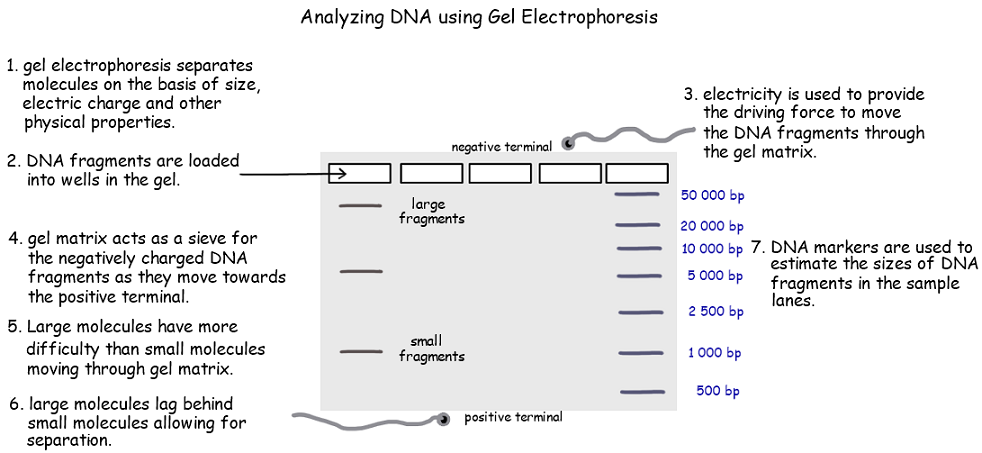
3.5.U2 PCR can be used to amplify small amounts of DNA.
- State the function of the PCR.
- Describe the selectivity of the PCR
Gel electrophoresis is a laboratory technique used to separate and isolate proteins or DNA fragments based on mass / size
- Samples are placed in a block of gel and an electric current is applied which causes the samples to move through the gel
- This causes samples of different sizes to separate as they travel at different speeds
- PCR – polymerase chain reaction that makes large numbers of copies of DNA can use PCR for forensic investigations
- PCR is used to copy specific DNA sequences by using a primer that binds
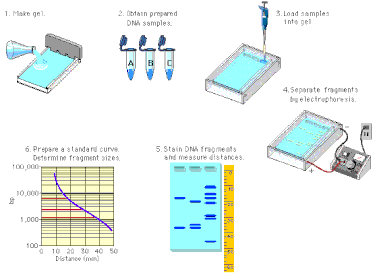
3.5.U3 DNA profiling involves comparison of DNA.
- Outline the process of DNA profiling.
DNA profiling involves the use of PCR and gel electrophoresis of DNA
- sample of DNA is obtained
- copied DNA is split into fragments using restriction endonucleases
- fragments separated by gel electrophoresis
- compared to see which bands are the same and which are different
Forensics: DNA fingerprinting for criminal cases
- collect samples of DNA-containing substance (blood, semen)
- from suspect
- from crime scene
- amplify quantity using PCR if necessary
- add endonucleases to produce DNA RFLPs
- use gel electrophoresis to separate RFLPs into DNA fingerprint
- compare samples from crime scene and suspect for match
DNA fingerprinting to determine identity
- collect samples of DNA-containing substance (blood, semen)
- from children
- from suspected father
- amplify quantity using PCR if necessary
- add endonucleases to produce DNA RFLPs
- use gel electrophoresis to separate RFLPs into DNA fingerprint
- compare samples from children and suspected father for matching RFLP pattern
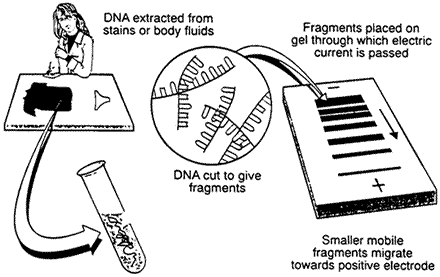 | 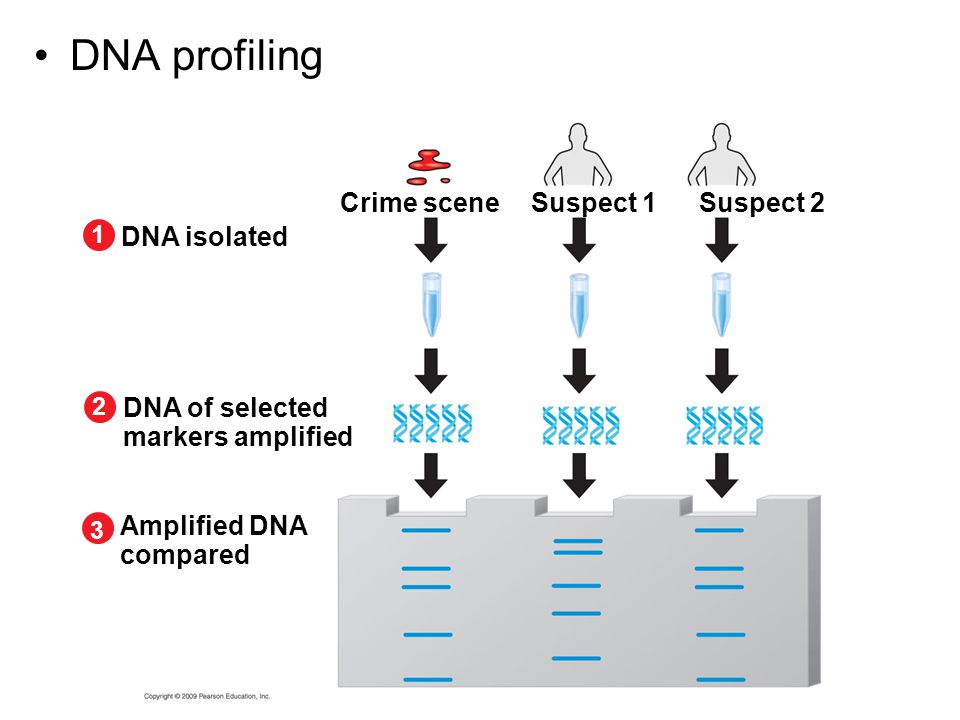 |
A gene determines a particular trait by encoding for a specific polypeptide in a given organism. Because the genetic code is (almost) universal, an organism can potentially express a new trait if the appropriate gene is introduced into its genome. The transfer of genes between species is called gene modification, and the new organism created is called a transgenic. When genes are transferred between species, the amino acid sequence translated from them is unchanged – the same polypeptide is produced. Genes are transferred from eukaryotes –> bacteria
- Example – goats produce that secrete milk containing spider silk protein – spider silk is immensely strong but spiders could not be used to produce it commercially
- GM crops
- Example of GM crops – golden rice involved the transfer of three genes

3.5.U5 Clones are groups of genetically identical organisms, derived from a single original parent cell. (
- Contrast sexual and asexual reproduction.
- Define clone and cloning.
- Describe different ways in which natural clones can arise.
Cloning Genes Animation

Clones are groups of genetically identical organisms that are derived from a single original parent cell. Cloning is the process through which these identical organisms are produced. The size of clones can range from two (i.e. identical twins) to hundreds (i.e. crops of commercially grown plants).
Organisms that reproduce asexually, which results in genetically identical organisms. Sexual reproduction produces genetically different organisms as a result of gamete fusion.
Binary Fission
- The parent organism divides equally in two, so as to produce two genetically identical daughter organisms
- This method of cloning occurs in Planaria (flatworms) but is also common to bacteria and protists (e.g. euglena, amoeba)
Budding
- Cells split off the parent organism, generating a smaller daughter organism which eventually separates from the parent
- This method of cloning occurs in Hydra but is also common to many species of yeast
Fragmentation
- New organisms grow from a separated fragment of the parent organism
- This method of cloning is common to starfish and certain species of annelid worms
Parthenogenesis
- Embryos are formed from unfertilised ova (via the production of a diploid egg cells by the female)
- This method of cloning occurs in certain species of insect, fish, amphibians and reptiles
Plant Cloning Methods
- Plants have the capacity for vegetative propagation, whereby small pieces can be induced to grow independently
- This is because adult plants possess meristematic tissue capable of cellular differentiation (totipotent)
- Virtually all types of roots and shoots are capable of vegetative propagation
- Garlic and onion bulbs are modified plant leaves – all the bulbs in a group are genetically identical
- Underground stems (e.g. potato tubers) can form new plants which are genetically identical to the parent plant
- Certain plants can form horizontal stems called runners (or stolons) that grow roots and develop into clones
- Some plants (mainly algae, mosses and ferns) can reproduce asexually by producing spores
- Spores are also produced by certain types of bacteria and fungi
Human Cloning Methods
- Even human beings are capable of creating genetic clones through natural means
- Identical twins (monozygotic) are created when a fertilised egg (zygote) splits into two identical cells, each forming an embryo
- Non-identical twins (dizygotic) are created when an unfertilised egg splits into two cells and each is fertilised by a different sperm
- Identical twins will be clones of one another (genetically identical), while non-identical twins will share 50% of the same DNA
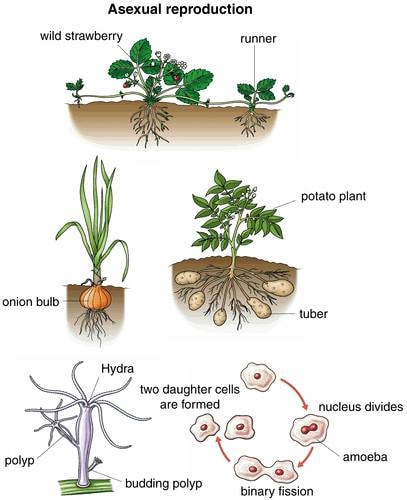
3.5.U7 Animals can be cloned at the embryo stage by breaking up the embryo into more than one group of cells.
- Describe the process of reproductive cloning via embryo splitting.
- Outline example of cloning animal embryos via natural and artificial embryo splitting.

3.5.U8 Methods have been developed for cloning adult animals using differentiated cells.
- Describe the process of cloning via somatic cell nuclear transfer.
Cloning farm animals
- differentiated mammary cells extracted from parent sheep; grown in nutrient-deficient solution to stop the cell cycl
- undifferentiated egg cells extracted from egg donor; nucleus removed and discarded
- mammary cell placed next to enucleated egg cell
- electric shock causes two cell membranes to fuse, and mitosis to trigger
- mitotic division continues, producing embryo
- embryo implanted into surrogate mother
- after 5-month gestation, Dolly the lamb born with identical genotype to parent donating nucleus from mammary cell
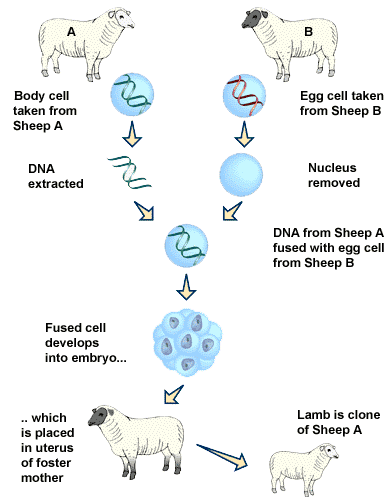
3.5.A1 Use of DNA profiling in paternity and forensic investigations.
- List example sources of DNA that can be used in DNA profiling
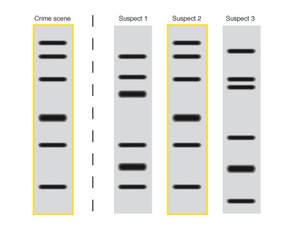
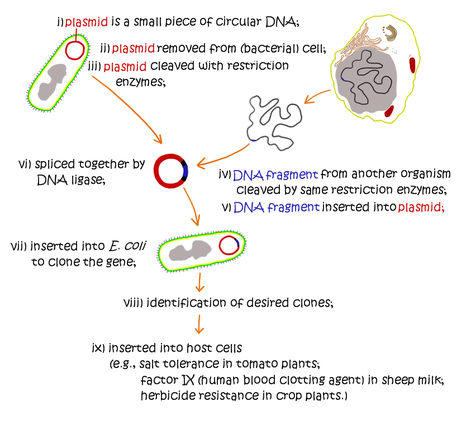
|
|
3.5.A4 Production of cloned embryos produced by somatic-cell nuclear transfer.
- Outline the production of Dolly the sheep using somatic cell nuclear transfer.
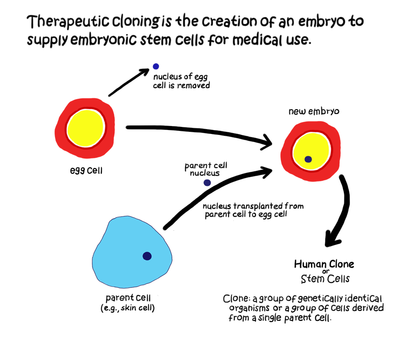
Artificial Embryo Twinning
- Low-tech version of cloning which mimics the natural processes of producing identical twins
- An egg is fertilized by sperm
- In the early stages of its formation, the embryo is split into individual cells
- Then placed in a in a surrogate to grow to a full organism
- The resulting offspring produced are identical
Somatic Cell nuclear Transfer
- Egg cell nucleus is removed and replace by the nucleus of a somatic cell (e.g. skin cell)
- Under certain conditions, the egg begins to replicate as though it was a fertilized embryo
A stem cutting is a separated portion of plant stem that can regrow into a new independent clone via vegetative propagation
- All stems possess nodes, from which a leaf, branch or aerial root may grow – the region between nodes are called internodes
- Stem cuttings are typically placed in soil with the lower nodes covered and the upper nodes exposed
- Stem cutting is a common method employed to rapidly propagate plant species (including sugar cane, grapes and roses)
There are a variety of factors that will influence successful rooting of a stem cutting, including:
- Cutting position (whether cutting occurs above or below a node, as well as the relative proximity of the cut to the node)
- Length of cutting (including how many nodes remain on the cutting)
- Growth medium (whether left in soil, water, potting mix, compost or open air)
- The use and concentration of growth hormones (e.g. IAA, IBA and NAA promote the formation of adventitious roots)
- Temperature conditions (most cuttings grow optimally at temperatures common to spring and summer)
- Availability of water (either in the form of ground water or humidity)
- Other environmental conditions (including pH of the soil and light exposure
3.5.S2 Analysis of examples of DNA profiles. (Oxford Biology Course Companion page 190).
- Analyze a DNA profile to determine relatedness or forensic guilt.
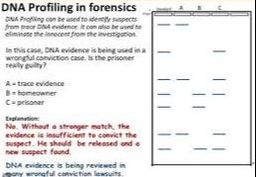 | 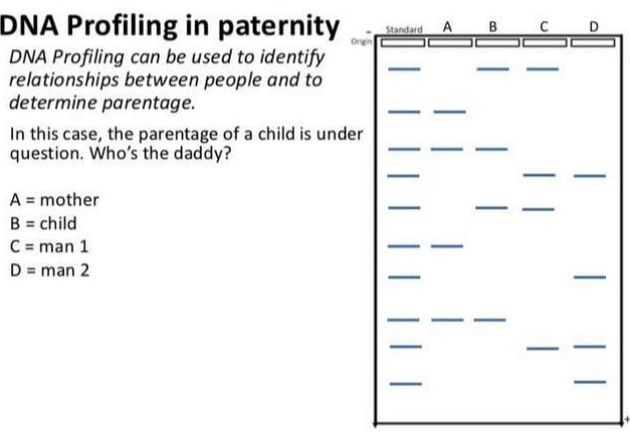 |
- Bacillus thuringienis (Bt) cor, is a transgenic plant, contains Bt gene encording CryIAb protein toxin
- Developed to suppress the European corn borer larvae (i.e. target organism) that feeds on the pollen grains that accumulate on corn leaves
- Also has unintended effects on species (e.g. monarch butterfly larvae; non-target organism) beyond transgenic field borders
- Feeds on milkweed plant but also ingests wind-dispersed pollen that has landed on the leaves
- The pollen contains the expensed insecticidal toxins of th eBt gene that kills monarch larva.
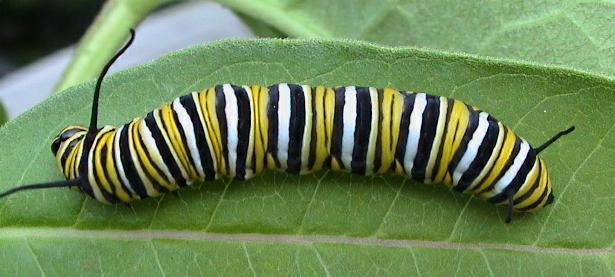 | 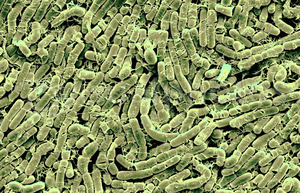 |
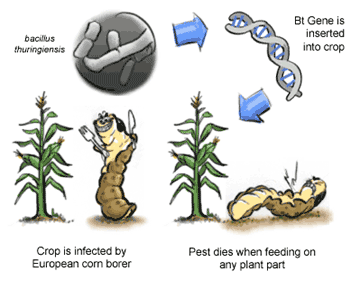
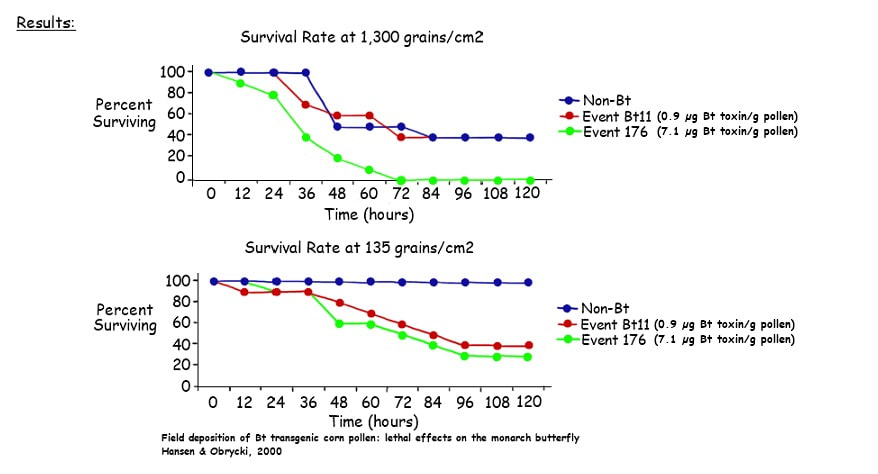
- Transgenic Bt corn pollen has a negative effect on effect on monarch butterfly larvae feedling next to Bt corn fields
- Both concentrations of pollen (i.e. amount of Bt gene toxin) decreased larval survival rates
- 1,300 grains/cm2 had lower survival rate than the 135 grains/cm2
- Therefore, higher concentrations of Bt gene toxin decreased larval survival rates
- Wind-dispersed pollen containing Bt gene toxin can cause larval mortality
- e.g. Event 176 pollen causes larval mortality in non-Bt plants
Biotechnology: Principles and Processes
Table of Contents
- Definition of Biotechnology
- Principles of Biotechnology
- Conceptual development of concepts of Genetic Engineering
- Tools of Recombinant DNA Technology
- Processes of Recombinant DNA Technology
- Frequently Asked Questions
Definition of Biotechnology
According to the European Federation of Technology, the term Biotechnology is defined as:
“The integration of natural science and organisms, cells, parts thereof, and molecular analogues for products and services.”
Principles of Biotechnology
Modern biotechnology is the result of the following two core techniques –
- Genetic Engineering – It includes several techniques that facilitate the alteration of genetic material, that is, RNA or DNA, in order to introduce them in host organisms. It includes changing of phenotype in host organism.
- In chemical engineering process, maintenance of microbial contamination free (sterile) atmosphere with an objective to initiate the large growth of desired eukaryotic or microbe cell in order to manufacture biotechnological products like enzymes, vaccines and antibiotics.
Conceptual development of Concepts of Genetic Engineering
Sexual reproduction is beneficial than asexual reproduction. This is so because sexual reproduction provides opportunity for formulation of new genetic set up and permits variation while asexual reproduction focuses on maintaining the genetic information. This idea plays the significant role in genetic engineering and has resulted in the creation of recombinant DNA, gene transfer and gene cloning. These processes have enabled the isolation of desirable gene without introducing undesirable one in the target organism.
When we focus on the construction of an artificial recombinant DNA molecule, it results the possibility of linking an encoding antibiotic resistance of a gene with an associated plasmid of Salomonella typhimurium. In 1972, Herbert Boyer and Stanley Cohen cut down the piece of DNA from plasmid and isolated the antibiotic resistance gene. This cutting of DNA was made possible by the discovery of molecular scissors (or restriction enzymes). The piece of DNA after being cut was linked or connected with plasmid DNA which acted as vectors to transfer the piece of DNA attached to it. An enzyme called DNA ligase (as it acts on cut DNA molecule and join there ends) made this linking possible and resulted in the development of in vitro and is referred as recombinant DNA.
Tools of Recombinant DNA Technology
The key tools of recombinant DNA technology are:
- Restriction Enzymes
- Polymerase Enzymes
- Ligases
- Vectors
- The Host Organisms
Restriction Enzymes
In order to limit the growth of bacteriophage in Escherichia coli, two enzymes were isolated in the year 1963, whereby first enzyme added methyl groups to DNA and was used to cut DNA (was termed as restriction endonuclease).
First Restriction Endonuclease – Hind II depended on the specific sequence of DNA nucleotide and always used to cut DNA molecule at a specific point after recognizing the base pairs sequence. This specific sequence of base pair is referred as recognition sequence. Besides Hind II, now we have around nine hundred restriction enzymes found from over 30 strains of bacteria. Each of these enzymes acknowledges different recognition sequences.
The restriction enzymes belong to larger class of enzymes called nucleases which are further classified as endonucleases and exonucleases. Endonucleases make cut at a specific position within DNA while exonucleases help in eliminating nucleotide from the end of DNA while,
Following diagram shows the steps in the formation of recombinant DNA. The restriction endonuclease enzyme – EcoRI plays an integral role in the formation, whereby each restriction endonuclease act by inspecting the length of DNA sequence. Once the specific recognition sequence is found, it binds with DNA and cut each of the strands of double helix at specific point in sugar phosphate backbone.

Palindromes – “Palindromes are the group of letters that form the same words when read both forward and backward, that is, MALAYALAM. Palindromes in DNA are the sequence of base pairs that reads same on the two strands when orientation of reading is kept same.”
Example of Palindromes:
The following sequence reads the same on two strands in 5’ → 3’ direction. This is again same if read in 3’ → 5’ direction.
5’ ——- GAATTC ——- 3’
3’ ——- CTTAAG ——- 5’
It is important to note that restriction enzymes cut DNA strand little far from the center of palindrome site. Added to this the cutting is carried out between the same 2 bases on opposite strands. This results in leaving of single stranded portion at the end. The overhanding stretches are called sticky end on each strand.
Restriction endonucleases are very useful in genetic engineering because it helps in forming ‘recombinant’ molecule of DNA (These molecules of DNA are composed of DNA from different genomes or sources).
Following diagram represent the recombinant DNA technology. It is important to note that when removed or cut by the same restriction enzyme, the resultant DNA fragments possess same kind of “sticky ends” and these fragments are joined together via DNA ligases.
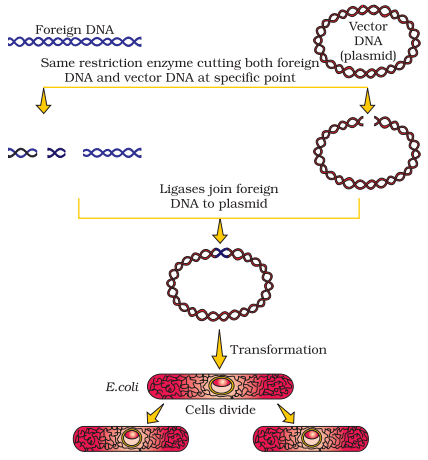
Separation and Isolation of DNA fragments
Restriction endonucleases form DNA fragments that are separated via technique gel electrophoresis. These DNA fragments are negatively charged molecule and is separated by moving them towards anode under an electric field via matrix or some medium. Most commonly used matrix is Agarose, a natural polymer extracted from sea weeds. The fragments of DNA are separated as per their size via sieving effect provided by agarose gel.
Following figure shows the gel electrophoresis instrumentation.
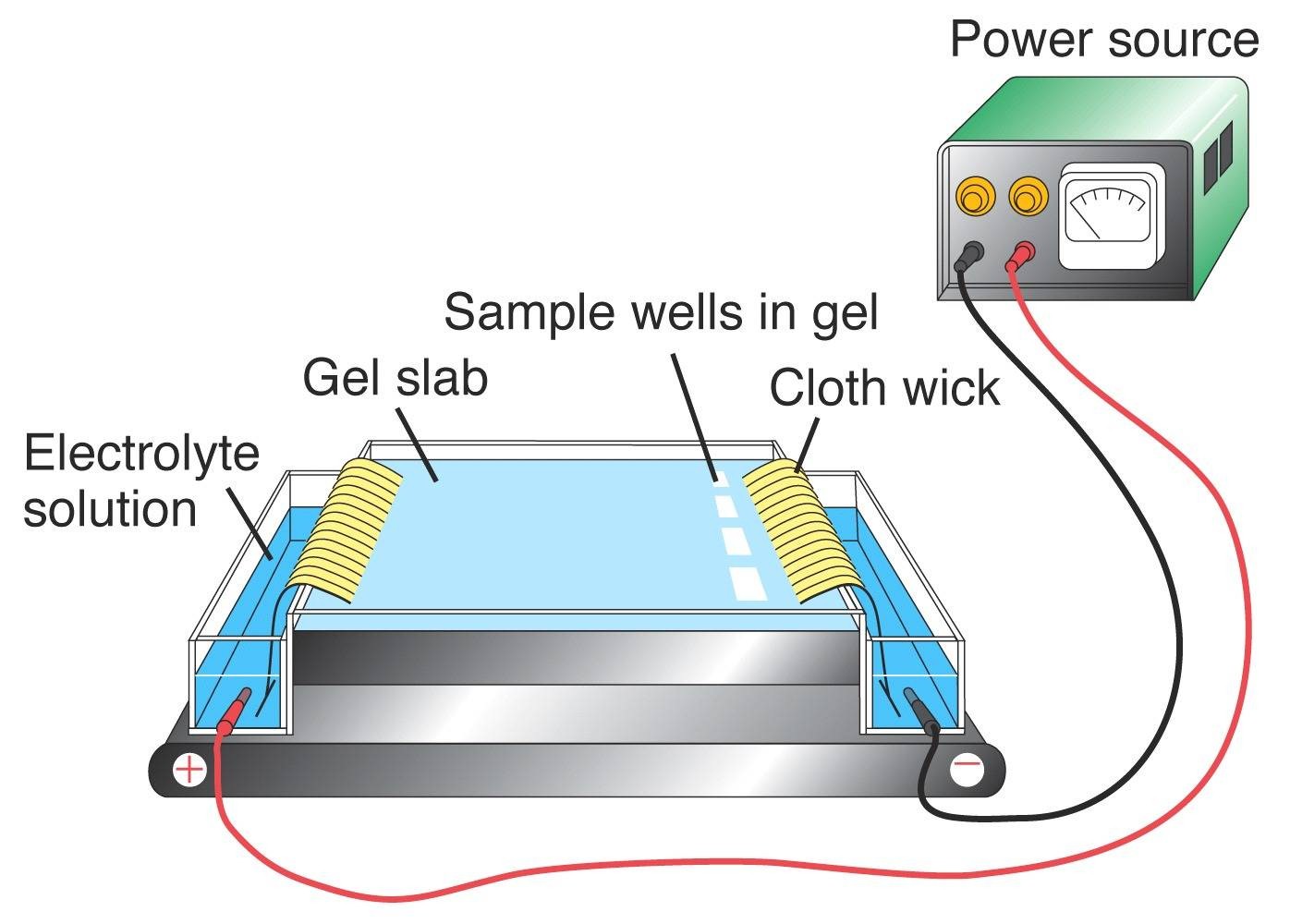
The separated DNA fragments are visible only after staining them with a compound called ethidium bromide.
Following figure shows the orange colored bands of DNA in ethidium bromide stained gel exposed to Ultra Violet light:
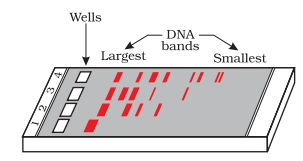
We all are aware of the fact that bacteriophages and plasmids have ability to replicate within bacterial cells and chromosomal DNA does not control this replication. Since, bacteriophages are very high per cell; they can easily copy their genome within bacterial cell. Added to this, plasmids have only 1 – 2 copies per cell. If we are able to connect an alien DNA piece with plasmid DNA or a bacteriophage, we are able to multiply its number equal to the copy number of plasmids and bacteriophage respectively. At present, vectors are engineered such that it facilitates easy linkage of foreign DNA along with selection of recombinants from non – recombinants.
Features required facilitating cloning into a vector
- Origin of replication – “It is the sequence where initiation or start of replication takes place and any DNA piece linked to this sequence is also replicated within host cells.” Origin of replication also helps in controlling the copy number of linked DNA, therefore, if anyone wants to recover several copies of target DNA, it must be cloned in vector whose origin support high copy number. Following image shows origin of replication of DNA.
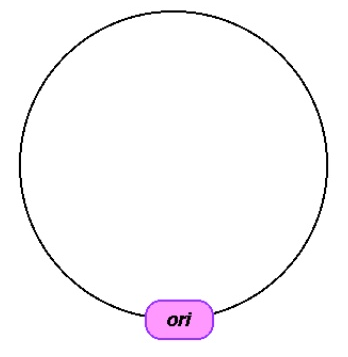
- Selectable marker – Vector require selectable marker so as to eliminate and identify non – transformants and permit the growth of transformants on the selective basis. “Transformation is the process via which new DNA piece is introduced in host bacterium.” In the following figure, the green arrows signifies the selectable marker which permits the growth of transformants on selective basis.

- Cloning Sites – Recognition site are used to link alien DNA for the commonly used restriction enzyme. In case there is more than one recognition site in the vector, it results in the generation of several fragments that complicates the gene cloning.
- Vectors for cloning genes in animals and plants – Genes are transferred in plants and animals via viruses and bacteria. For instance, “Agrobacterioum tumifaciens, a pathogen of several dicot plants is able to deliver a piece of DNA called T-DNA to transform normal plant cells into tumor and direct these tumor cells to produce the chemical required by pathogen.” Similarly, in animals, retrovirus has the ability to transform normal cells in cancerous cells.
Competent Host (For Transformation with Recombinant DNA)
DNA is a hydrophilic molecule and therefore cannot pass through cell membrane. So, in order to force bacteria, to take up plasmid, the bacterial cells are first made “competent” via by treating them with specific concentration called divalent cation like calcium. Recombinant DNA is then forced into the cells by incubating cells on ice along with recombinant DNA.
This is not the only method of introducing alien DNA in host cells, rather a method called micro – injection as is directly injected into the nucleus of animal cells.
Processes of Recombinant DNA Technology
It includes several steps like:
- Isolation of DNA – DNA is enclosed in membrane; therefore, it is important to break the cells open in order to release DNA along with several other macromolecules like RNA, proteins, lipids and polysaccharides. This isolation process is carried out in the presence of several enzymes like cellulase (plant cells), lysozyme (bacteria) and chitinase (fungus).
- Cutting of DNA at specific locations – Restriction enzyme digestions are carried out by incubating purified DNA molecule with restriction enzyme in suitable conditions. Progression of restriction enzyme digestion is checked by Agarose gel electrophoresis. Since, DNA is charged negatively, it is attracted towards positive electrode and this entire process is repeated with the vector DNA as well.
Following is the diagrammatic representation of basic steps in recombinant DNA technology, using the bacterial plasmid as cloning vector. At initial stage, construction of recombinant DNA molecule takes place, then the cell is transported in host cells, followed by multiplication of recombinant DNA molecule, then division and finally the division results in a clone.

- Amplification of Gene of Interest using PCR – In Polymerase Chain Reaction (PCR), several copies of gene (or DNA) is formed in vitro taking help of two sets of primers. The enzyme with nucleotides extends the primers provided in reaction and the genomic DNA as template. Repetitive occurrence of this DNA replication, results in the amplification of segment of DNA to billion times. This repeated amplification is achieved by an enzyme thermostable DNA polymerase.
- Insertion of Recombinant DNA into the Host cells/ Organisms – Several methods are used to introduce litigated DNA into recipient cells after making them competent to receive and take up DNA present in its surroundings.
- Obtaining the Foreign Gene Product – While inserting the alien DNA piece in cloning vector, the multiplication of alien DNA takes place. In almost all recombinant technologies, the main objective is to produce desirable protein and therefore, it is important to express recombinant DNA. The foreign gene is expressed under appropriate conditions and the expression of this gene in host cells includes understanding of many technical details.
- Downstream Processing – After biosynthetic stage, the product is subjected through a series of processes like separation and purification, which aims at forming the finished product before marketing. These products are prepared with suitable preservatives and downstream process and quality control testing vary from product to product.
Frequently Asked Questions
Q1. Explain the contribution of Thermus aquaticus in the amplification of a gene of interest.
Sol. “Thermus aquaticus provides thermostable DNA polymerase, which can withstand high temperature required in denaturation and seperationf of DNA strands during PCR, i.e. Polymerase Chain Reaction.”
Q2. What are recombinant proteins? How do bioreactors help in their production?
Sol. “Recombinant proteins are produced by the expression of recombinant DNA in transgenic organisms.” Bioreactors help in developing recombinant proteins on large scale as large volumes of culture can be processed in bioreactors to produce desired quality of product and these have capability to provide optimum conditions of oxygen, pH, salts, substrates, etc.
Q3. What are bioreactors and how does it work?
Sol. “Bioreactors are large vessels in which raw materials are biologically converted into specific products by microbes, plants and animals.” The reactors work by providing optimum condition to the process of culture by maintaining optimum temperature, oxygen, salt, pH and other required conditions. The two most commonly used bioreactors are Simple Stirred – tank bioreactors and Sparged Stirred – tank bioreactors.
Following figure shows the general structure of a continuous stirred tank type bioreactor:
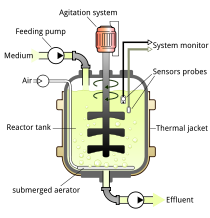
Q4. Do eukaryotic cells have restriction endonucleases?
Sol. No, eukaryotic cells do not possess restriction endonucleases. This is so because all restriction endonucleases have been isolated from various strains of bacteria and are name as per genus and species. The first letter of enzyme comes from genus and second letter from species of prokaryotic cells from which they are isolated.
